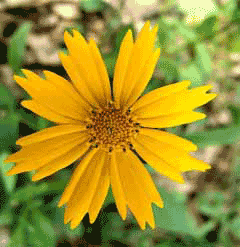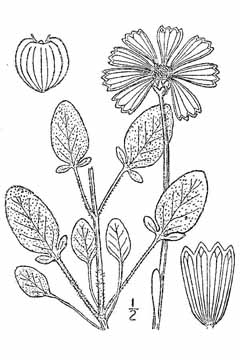 |
|
http://flickr.com/photos/54289096%40N00/ |
 |
| USDA-NRCS PLANTS Database / Britton, N.L., and A. Brown. 1913. An illustrated flora of the northern United States, Canada and the British Possessions. Vol. 3: 491. |
Translate this page:
Summary
Bloom Color: Yellow.
Main Bloom Time: Early summer, Early fall, Late summer, Late spring, Mid summer. Form: Upright or erect.
Physical Characteristics

 Coreopsis auriculata is a PERENNIAL growing to 1.5 m (5ft) at a medium rate.
Coreopsis auriculata is a PERENNIAL growing to 1.5 m (5ft) at a medium rate.
See above for USDA hardiness. It is hardy to UK zone 4. It is in flower from July to August. The species is hermaphrodite (has both male and female organs) and is pollinated by Bees.
It is noted for attracting wildlife.
Suitable for: light (sandy) and medium (loamy) soils and prefers well-drained soil. Suitable pH: mildly acid, neutral and basic (mildly alkaline) soils. It cannot grow in the shade. It prefers dry or moist soil and can tolerate drought.
UK Hardiness Map
US Hardiness Map
Synonyms
Plant Habitats
Woodland Garden Sunny Edge; Dappled Shade;
Edible Uses
References More on Edible Uses
Medicinal Uses
Plants For A Future can not take any responsibility for any adverse effects from the use of plants. Always seek advice from a professional before using a plant medicinally.
None known
References More on Medicinal Uses
The Bookshop: Edible Plant Books
Our Latest books on Perennial Plants For Food Forests and Permaculture Gardens in paperback or digital formats.

Edible Tropical Plants
Food Forest Plants for Hotter Conditions: 250+ Plants For Tropical Food Forests & Permaculture Gardens.
More

Edible Temperate Plants
Plants for Your Food Forest: 500 Plants for Temperate Food Forests & Permaculture Gardens.
More

More Books
PFAF have eight books available in paperback and digital formats. Browse the shop for more information.
Shop Now
Other Uses
Dye
Landscape Uses: Border, Container, Massing.An orange to red/orange dye is obtained from the flowers and stems[168]. Established plants are drought resistant[1]. Special Features: Attracts birds, North American native, Naturalizing, Attracts butterflies, Suitable for cut flowers. The shorter cultivar Coreopsis auriculata 'Nana' (Dwarf Mouse-ear Tickseed, Lobed Tickseed 'Nana’) is a good low ground cover performing best with consistent moisture.
Special Uses
Attracts Wildlife Food Forest
References More on Other Uses
Cultivation details
Succeeds in ordinary garden soil[1]. Prefers a fertile well-drained moisture retentive medium soil[111, 200]. Requires a sunny position[111, 200]. Established plants are drought resistant[1]. Plants are apt to die out overwinter if they are grown on clay soils[111]. A good bee plant[200]. The plant is heat tolerant in zones 9 through 1. (Plant Hardiness Zones show how well plants withstand cold winter temperatures.
Plant Heat Zones show when plants would start suffering from the heat.
The Plant Heat Zone map is based on the number of "heat days" experienced in a given area where the temperature climbs to over 86 degrees F (30°C).
At this temperature, many plants begin to suffer physiological damage. Heat Zones range from 1 (no heat days) to 12 (210 or more heat days).
For example Heat Zone. 11-1 indicates that the plant is heat tolerant in zones 11 through 1.) For polyculture design as well as the above-ground architecture (form - tree, shrub etc. and size shown above) information on the habit and root pattern is also useful and given here if available. The plant growth habit is a clumper with limited spread [1-2]. The root pattern is fibrous dividing into a large number of fine roots [1-2]. The root pattern is stoloniferous rooting from creeping stems above the ground [1-2]. The shorter cultivar Coreopsis auriculata 'Nana' (Dwarf Mouse-ear Tickseed, Lobed Tickseed 'Nana’) is useful for borders, edging, rock gardens and ground cover performing best with consistent moisture. It spreads by stolons but is not invasive. Height: 15-30 cm (6-12 in) Spread: 15-30 cm (6-12 in).
References Carbon Farming Information and Carbon Sequestration Information
Temperature Converter
Type a value in the Celsius field to convert the value to Fahrenheit:
Fahrenheit:
The PFAF Bookshop
Plants For A Future have a number of books available in paperback and digital form. Book titles include Edible Plants, Edible Perennials, Edible Trees,Edible Shrubs, Woodland Gardening, and Temperate Food Forest Plants. Our new book is Food Forest Plants For Hotter Conditions (Tropical and Sub-Tropical).
Shop Now
Plant Propagation
Seed - sow March in a cold frame. When they are large enough to handle, prick the seedlings out into individual pots and plant them out into their permanent positions in the summer[111]. The seed can also be sown in an outdoor seedbed in mid spring. Once they are more than 15cm tall, plant the seedlings out into their permanent positions in the summer. Division in spring or autumn[111]. Very easy, larger clumps can be replanted direct into their permanent positions, though it is best to pot up smaller clumps and grow them on in a cold frame until they are rooting well. Plant them out in the summer or following spring. Cuttings of young basal shoots, May/June in a frame[200]. Harvest the shoots when they are about 10cm long with plenty of underground stem. Pot them up into individual pots and keep them in light shade in a cold frame or greenhouse until they are rooting well. Plant them out in the summer.
Other Names
If available other names are mentioned here
The shorter cultivar Coreopsis auriculata 'Nana' is known as Dwarf Mouse-ear Tickseed, Lobed Tickseed 'Nana’.
Native Range
NORTHERN AMERICA: United States, West Virginia, Alabama, Florida, Georgia, Kentucky, Louisiana, Mississippi, North Carolina, South Carolina, Tennessee, Virginia,
Weed Potential
Right plant wrong place. We are currently updating this section.
Please note that a plant may be invasive in one area but may not in your area so it's worth checking.
Conservation Status
IUCN Red List of Threatened Plants Status :

Growth: S = slow M = medium F = fast. Soil: L = light (sandy) M = medium H = heavy (clay). pH: A = acid N = neutral B = basic (alkaline). Shade: F = full shade S = semi-shade N = no shade. Moisture: D = dry M = Moist We = wet Wa = water.
Now available:
Food Forest Plants for Mediterranean Conditions
350+ Perennial Plants For Mediterranean and Drier Food Forests and Permaculture Gardens.
[Paperback and eBook]
This is the third in Plants For A Future's series of plant guides for food forests tailored to
specific climate zones. Following volumes on temperate and tropical ecosystems, this book focuses
on species suited to Mediterranean conditions—regions with hot, dry summers and cool, wet winters,
often facing the added challenge of climate change.
Read More
Expert comment
Author
L.
Botanical References
43200
Links / References
For a list of references used on this page please go here
Readers comment
| Add a comment |
|
If you have important information about this plant that may help other users please add a comment or link below. Only comments or links that are felt to be directly relevant to a plant will be included. If you think a comment/link or information contained on this page is inaccurate or misleading we would welcome your feedback at [email protected]. If you have questions about a plant please use the Forum on this website as we do not have the resources to answer questions ourselves.
* Please note: the comments by website users are not necessarily those held by PFAF and may give misleading or inaccurate information.
To leave a comment please Register or login here All comments need to be approved so will not appear immediately.
|
Subject : Coreopsis auriculata
|
|
|
|